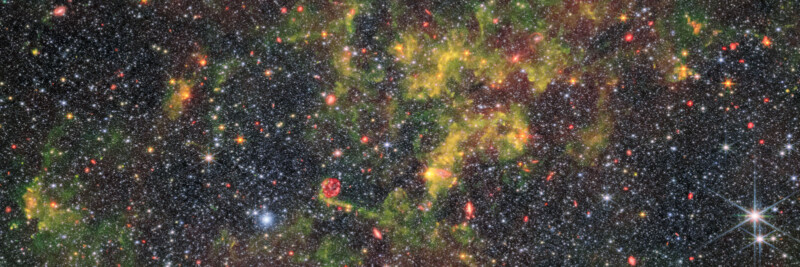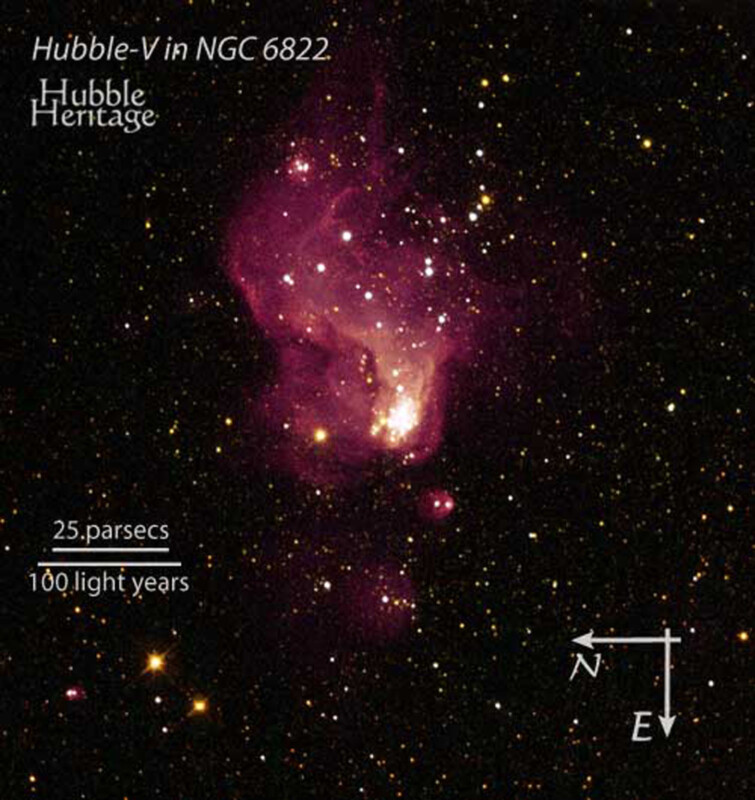Webb’s Photo of This Influential Galaxy Teaches a lot About the Early Universe

The James Webb Space Telescope recently captured a colorful image of the irregular galaxy NGC 6822. Using its Near InfraRed Camera (NIRCam) and Mid-InfraRed Instrument (MIRI), Webb observed different aspects of NGC 6822, including gas-rich regions and specific organic compounds critical for star and planetary formation.
Although grand, gorgeous spiral galaxies often get significant attention, irregular galaxies such as NGC 6822, also known as Barnard’s Galaxy, also form stars and deserve to be showcased.
Beyond the constellation Sagittarius, Barnard’s Galaxy is about 1.5 million light-years from Earth and is part of the “Local Group” of galaxies. Although on the smaller side in galactic terms, NGC 6822 is still about 7,000 light-years across.

While not regularly celebrated for its beauty, NGC 6822 is a familiar target for space telescopes. Hubble has investigated the region on numerous occasions, while an international team using the Subaru telescope recently performed multi-band photometric observations of the galaxy.
Phys.org explains, “NGC 6822 is an excellent observational target as its position on the sky is such that it can be observed from both the northern and the southern hemisphere. Its modest distance allows many multi-band investigations ranging from the optical to the near-infrared (NIR) and to the mid-infrared (MIR). Moreover, its mean metal-intermediate chemical composition and the identification of solid young, intermediate-age and old stellar tracers and its apparent isolation make NGC 6822 a very interesting laboratory for stellar pulsation and evolution.”

That last sentence is worth homing in on. NGC 6822 has low metallicity, which means that it includes low proportions of elements other than hydrogen and helium. Elements beyond H and He — all other known elements — are primarily produced by stars throughout their lifetimes. This makes NGC 6822 an interesting region for understanding more about the nature of the early universe when there was not much metal content present.

The study of NGC 6822 goes back a long time, way before scientists dreamed up space telescopes. The galaxy was first discovered by its namesake, E.E. Barnard, who wrote about it in 1884. As was often the case with celestial objects like NGC 6822, Barnard mischaracterized it as an “exceedingly faint nebula.” Over the next few years, more confusion arose concerning NGC 6822.
Edwin Hubble studied the galaxy in depth and published an influential paper in 1925.

“N.G.C. 6822, [was] the first object definitely assigned to a region outside the galactic system,” Hubble explained. Hubble’s work was vital in expanding humanity’s understanding of the universe. At the time, it was far from settled science that there even were objects beyond the Milky Way.
In the 1960s, Susan Keyser, the first woman to receive a doctorate in astronomy from Caltech, continued Hubble’s work in her thesis. Keyser’s work was the most in-depth study of NGC 6822 until the 2000s.
Today, the $10 billion, groundbreaking James Webb Space Telescope continues the work of so many who have come before, including Barnard, Hubble, and Keyser.
Image credits: ESA/Webb, NASA & CSA, M. Meixner